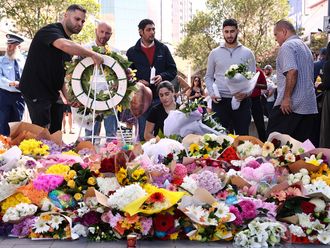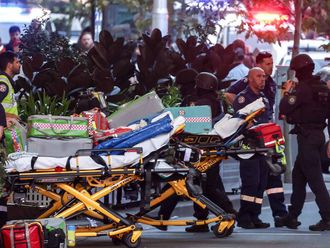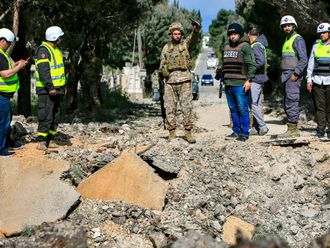
Adelaide, Australia: A large koala ornament in the front garden hints at what visitors will find when they walk through the garage of Anne and Don Bigham’s home in Glengowrie, South Australia, an Adelaide suburb.
In the backyard are two enclosures with about 20 koalas, usually in various stages of a nice nap. Anne Bigham, a wildlife caregiver, can often be seen there holding an orphaned baby koala that is sucking furiously on a bottle of milk.
Three decades ago, that milk would likely have been from a cow, causing diarrhoea and other stomach problems in the joey, as baby koalas are known. But today, what they are drinking is a man-made powdered milk formula that mirrors the fat, protein and sugar composition of the milk from a koala mother.
Wombaroo, the local, family-owned company behind the milk, has a growing international reach within its obscure niche: powdered milk formulas for exotic baby animals. Its list of products ranges from lion milk to kangaroo milk and panda milk.
The company, whose name combines wombat and kangaroo, is one of a handful of organisations around the world doing research in this area, in a race against time to give the hand-reared young of threatened species the best chance of survival.
“There are 4,000 mammals,” said Gordon Rich, 42, a chemical engineer and a part-owner of Wombaroo. “And for each of them, the milk is different. That is a huge spectrum.”
Rich’s father, Brian Rich, a biochemist, started Wombaroo in 1984 after a pharmaceutical career. He began dabbling in bird food but then saw the need for a powdered milk formula that wildlife caregivers could feed to orphaned kangaroo joeys.
Driving the need for a species specific formulas was that kangaroos could not digest the lactose in cow milk. They also needed higher levels of protein and fat to develop properly.
“It started out as an interest and then the demand came,” said Brian Rich, 78. “It was literally on the kitchen table making up formulas to start with.”
After the kangaroos came milk formulas for echidnas (whose babies are called puggles), sugar gliders, wombats and other Australian native animals.
Some species such as koalas have a few different formulas available to reflect how a mother’s milk changes as the babies develop.
In 2017, Francis Cabana, an animal nutritionist at Wildlife Reserves Singapore, which manages zoos in the country, worked with Wombaroo to produce a milk powder for two manatees. The manatee calves were not suckling with their mothers well and needed hand-rearing. The zoo had used a modified version of a generic milk replacer, but the faeces of the baby manatees were not as firm as Cabana wanted.
“Really, they are like little machines,” he said of the manatees. “You put in the right fuel and they run effortlessly,” he said.
With the new manatee milk formula, the calves’ stool is healthier, Cabana said.
It typically takes the team at Wombaroo a few days to create and manufacture a new formula. First, they look into what research and milk analysis have been done for the particular species. If there is no research, they look to animals that might have similar milk. The matches can be surprising, like using the composition of horse milk as a guide to create something for a baby rhinoceros. The two animals have similar digestive systems and lifestyles, according to Gordon Rich.
The base of each Wombaroo formula is derived from cow’s milk. But a custom mix of nutrients, fats, proteins and sugars, like vegetable oil and whey protein, are then added to match as closely as possible with the mother’s milk from each animal species. Among the more than two dozen ingredients in the kangaroo formula: biotin, choline, inositol, calcium, phosphorus, potassium, sodium, magnesium, zinc, iron, manganese, copper, iodine and selenium.
Among the other organisations researching milk for exotic baby animals is the Smithsonian Conservation Biology Institute in Washington, which has a milk repository with samples from 184 animals.
“Over the last 10 years, the number of species that we know about their milk has probably gone up two or three times,” said Michael L. Power, the scientist who heads up the repository. “Not that long ago, we almost knew nothing about gorilla or orang-utan milk.”
Besides building a better understanding of lactation across species, the repository also shares its research with zoos around the world that are hand-rearing young animals. Power is also tracking down more milk samples, especially from endangered species such as pangolins and sloths.
Laws against the trafficking of endangered species can complicate the legal export of an animal’s milk samples. Transportation costs are also significant, with dry ice required so the milk doesn’t spoil.
“You can’t just put a sample of milk in a bottle and put it in your pocket and get on an aeroplane,” Power said.
Wombaroo has its own exporting problems. Its formulas are considered dairy products, and the company says it has been too costly to comply with local regulations to ship its formulas to zoos in Europe and the United States.
Obtaining the milk samples in the first place can also be a challenge.
Since 2003, Garry Osthoff, a professor at the University of the Free State in South Africa, has gathered milk samples from animals including gorillas, lions and springbok. Often this happens when the animal is tranquillised.
For an elephant, keepers had to trick a nursing mother into letting them stimulate one of her teats. Osthoff described the milk flow as “like a shower” rather than the linear stream from a cow’s teat.
As human activity continues to put pressure on animal habitats around the world, more species are likely to have to be hand-reared in zoos, Osthoff said, making it an imperative to learn more about the milk of endangered species.
At the Adelaide Zoo in Australia, which shares a research lab with Wombaroo, Ian Smith, a senior veterinarian, was in and out of urgent meetings in late January. A giraffe had given birth a day earlier at Monarto Zoo, the Adelaide Zoo’s open-range counterpart about 43 miles outside the city.
The baby was not feeding, and caregivers had “observed negative interactions” with its mother, Smith said. “The mum was pushing her away, avoiding it, nudging it away with its head.”
If the situation did not improve within hours, caregivers would isolate the animal and begin a feeding program, starting with colostrum, an ultranutritious substance that mammals produce for a few days after birth to build a baby’s immune system. It could take nine months and about 550 gallons of milk mix before the giraffe is weaned.
Wombaroo had its colostrum product and giraffe formula ready to go. “You have this opportunity to improve its immune system,” Gordon Rich said. “In a couple of days, it goes downhill and you’ve lost that opportunity.”












